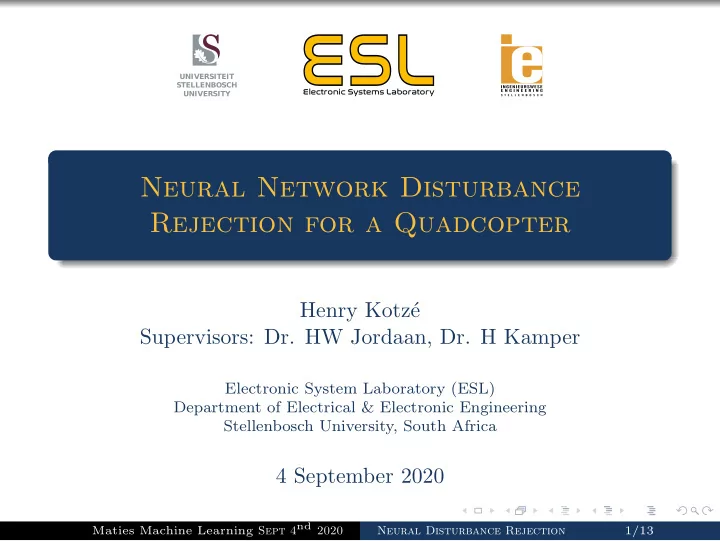

ESL UNIVERSITEIT STELLENBOSCH Electronic Systems Laboratory UNIVERSITY Neural Network Disturbance Rejection for a Quadcopter Henry Kotz´ e Supervisors: Dr. HW Jordaan, Dr. H Kamper Electronic System Laboratory (ESL) Department of Electrical & Electronic Engineering Stellenbosch University, South Africa 4 September 2020 Maties Machine Learning Sept 4 nd 2020 1/13 Neural Disturbance Rejection
ESL Background Electronic Systems Laboratory Quadcopters are being introduced in various sectors for proximity inspection, delivery and surveillance purposes. These requirements introduces phenomena not encounter by the hobbyist. A phenomenon during take-off and landing of a quadcopter is ground effects. Transporting a suspended Inspecting walls package Maties Machine Learning Sept 4 nd 2020 2/13 Neural Disturbance Rejection
ESL Background Electronic Systems Laboratory Ground effects are seen as disturbance from a control system perspective. It is omitted during the mathematical modelling and thus the control system is unaware of these dynamics. Obtaining a mathematical model is very difficult. Neural networks can be of use in this regards. Ground Effects Maties Machine Learning Sept 4 nd 2020 3/13 Neural Disturbance Rejection
ESL Our Approach Electronic Systems Laboratory The neural network assist the classical controller and does not replace it. The neural network should provide an estimate of this disturbance using the sensor measurements. This estimated disturbance can be introduced in the controller architecture to improve the disturbance rejection. Disturbances Sensor Noise Plant Output Σ Σ u Σ Controller Plant r Disturbance Observer Active disturbance rejection Maties Machine Learning Sept 4 nd 2020 4/13 Neural Disturbance Rejection
ESL Sim2Real Electronic Systems Laboratory Data generation does not scale well in robotics. Training data is generated in a simulation environment. Gazebo is a physic engine to simulated rigid body dynamics. Includes realistic sensor models. Quadcopter in Gazebo. Maties Machine Learning Sept 4 nd 2020 5/13 Neural Disturbance Rejection
ESL Simulated Flight Electronic Systems Laboratory The setpoints which the quadcopter flies contains step, ramp and exponential functions. Disturbances are random pulse trains in each body direction. 4 Force or Torque - [N] or [N/m] 2 0 − 2 − 4 0 200 400 600 800 1000 Time step - [ms] Setpoint containing expected properties. Random pulse train Maties Machine Learning Sept 4 nd 2020 6/13 Neural Disturbance Rejection
ESL Doman Randomisation Electronic Systems Laboratory Environmental and model variables are randomised. Helps with Sim2Real tranfer. Model must learn multiple environments. Parameter Scaling factor range Additive term range mass uniform([0.95,1.05]) - principles of inertia uniform([0.95,1.05]) - products of inertia - uniform([0,0.0005]) N (0 , 0 . 2) gravity vector(x,y,z) - Ranges of physics parameter randomisations Maties Machine Learning Sept 4 nd 2020 7/13 Neural Disturbance Rejection
ESL Learning to Identify Disturbances Electronic Systems Laboratory The neural network must first learn how a quadcopter behaves without disturbances. Any deviation from the expected behaviour is the manifestation of a disturbance. By viewing the correct signals, the neural network aught to identify when a disturbance is occurring and estimating its force. Force disturbance in body x-direction -[N] Pitch reference 2 40 Disturbance Pitch angle reference -[degrees] Pitch 20 1 0 0 − 20 − 1 − 40 − 2 0 1000 2000 3000 4000 Maties Machine Learning Sept 4 nd 2020 Timestep -[ms] 8/13 Neural Disturbance Rejection
ESL Training Data Electronic Systems Laboratory Input to neural network is a time window of about 0.3s Time window contains 24 vectors corresponding to the quadcopters position, velocity, acceleration and more. Maties Machine Learning Sept 4 nd 2020 9/13 Neural Disturbance Rejection
ESL Disturbance Neural Network Electronic Systems Laboratory Based on OpenAI’s neural network architecture Dense ReLU layer with LSTM Optimiser: Adam Estimated Disturbance [3 , 1] LSTM [512] Fully Connected ReLU [1024] Normalised Noisy Observation [50 , 27] Maties Machine Learning Sept 4 nd 2020 10/13 Neural Disturbance Rejection
ESL Disturbance Rejection Electronic Systems Laboratory Feeding the estimated disturbance in the correct feedback loop of the control system will counteract the disturbance much faster than originally. Disturbances Sensor Noise Plant Output Σ Σ u Σ Controller Plant r Disturbance Observer Maties Machine Learning Sept 4 nd 2020 11/13 Neural Disturbance Rejection
ESL Responses from Disturbance Observers Electronic Systems Laboratory 0.07 0.06 0.05 0.04 0.03 0.02 0.01 0 -0.01 -0.02 -0.03 0 500 1000 1500 2000 2500 3000 3500 4000 Response of quadcopter using standard control laws and using disturbance rejection with neural network. Maties Machine Learning Sept 4 nd 2020 12/13 Neural Disturbance Rejection
ESL Thank you Electronic Systems Laboratory Questions? Any suggestions is appreciated Maties Machine Learning Sept 4 nd 2020 13/13 Neural Disturbance Rejection
Recommend
More recommend